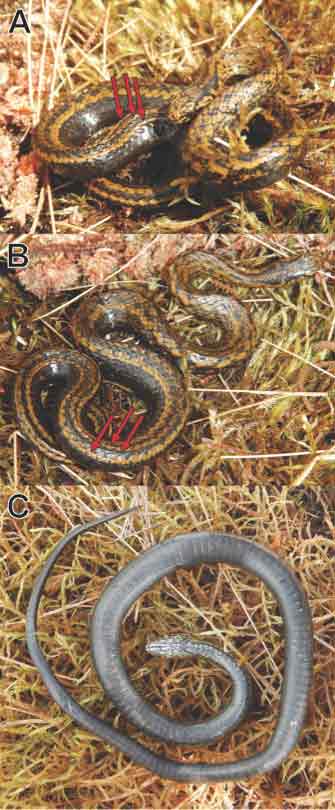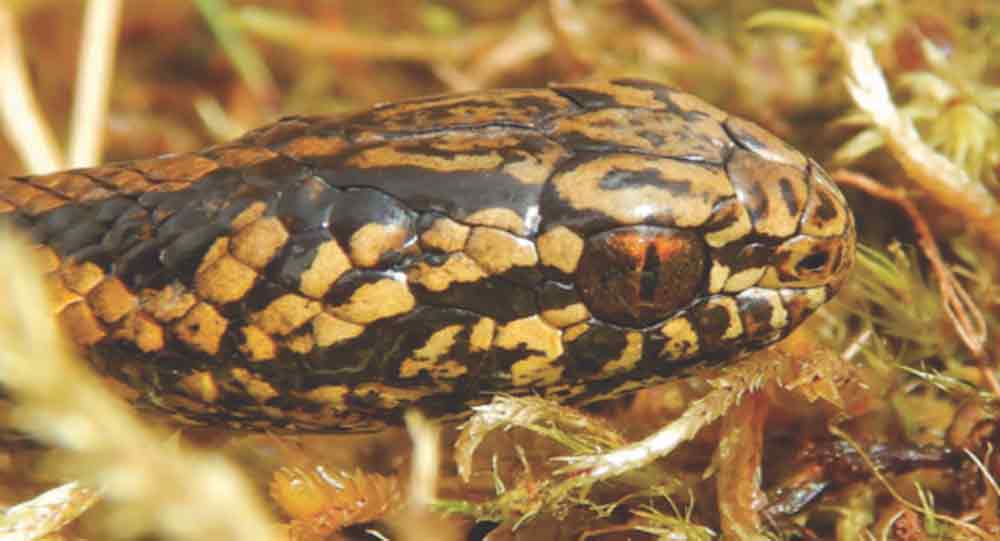An unusual snake character that Tachymenoides harrisonfordi sp. n. displays, are the three longitudinal skin folds on the posterior dorsal/dorsolateral body that look like keels.
Indiana Jones was afraid of snakes. In the movies, the character played by Harrison Ford wasn’t afraid of a whole lot, except the slithering reptiles. In Raiders of the Lost Ark, Jones had to contend with thousands of snakes and legless lizards as he traipsed around the world seeking treasure.

Figure 4. Living holotype of Tachymenoides harrisonfordi sp. n. (MUSM 40925) in dorsolateral (A), dorsal (B), and ventral views (C). The red arrows point to the skin folds. Total length of the snake is 407 mm. Photo via the paper “A new species of Tachymenoides (Serpentes: Dipsadidae: Tachymenini) from the puna of the Otishi National Park in Peru.”
The movie didn’t go unnoticed with researchers at the Department of Biology, Illinois Wesleyan University, Departamento de Herpetología, Museo de Historia Natural Universidad Nacional Mayor de San Marcos, Av. Arenales 1256, Jesús María, Lima, Peru, Department of Biological Sciences, Florida International University and the Centro de Ornitología y Biodiversidad and the Instituto Peruano de Herpetología, Lima Peru. They named a new snake species discovered in Otishi National Park, after the veteran actor.
New Lizard Species Of The Genus Proctoporus Discovered In Peru
Colorful Species Of Wood Lizard Discovered In Peru
The snake, of the genus Tachymenoides, is named Tachymenoides harrisonfordi, or Harrison Ford’s Slender Snake. The holotype, a male, measured 407mm in length, or 16 inches. Its dorm is pale yellowish brown with black blotches that form a paravertebral stripe that is one scale wide on each side of the body, the researchers wrote. The throat and the first 60mm of the ventral body are pale yellowish tan and feature black flecks. A 60mm ventrolateral black stripe is found on each side of the snake. The head is adorned with a black stripe near the back.
A female specimen was unable to be collected. The snake lives in high elevation wetlands in southern Peru, in an area rife with narco-trafficking.
“An unusual snake character that Tachymenoides harrisonfordi sp. n. displays, are the three longitudinal skin folds on the posterior dorsal/dorsolateral body that look like keels, the researchers wrote. “Whereas skin folds in snakes can be the outcome of malnutrition, after having given birth or after oviposition, the presence of the folds in the male specimen does not seem to be the result of malnutrition.”
The researchers believe the snake is a predator to Proctoporus titans, a lizard species found in the same locality. It was found in the mid-morning basking on moss in a swamp, in between Peruvian feather grass.
“We dedicate this species to Harrison Ford, actor and conservationist, in recognition of his work for Conservation International and his voice for nature (“Nature is speaking – Harrison Ford is The Ocean”),” the researchers wrote in the research paper.
The complete paper, “A new species of Tachymenoides (Serpentes: Dipsadidae: Tachymenini) from the puna of the Otishi National Park in Peru” can be read on Salamandra, the German Journal of Herpetology.



